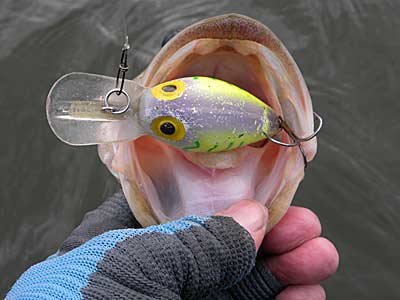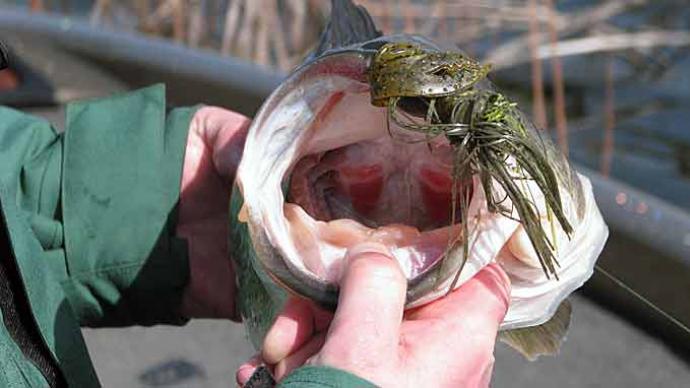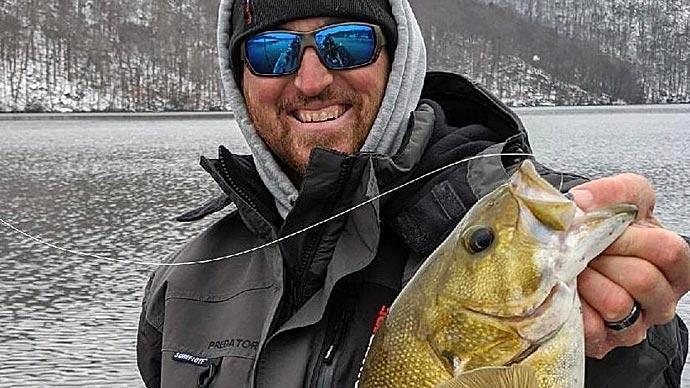
When we hit the winter months on the calendar, some take some time off because the bite and conditions get tough. But, at the same time, others take winter head-on and take advantage of the reduced number of fishermen. Whatever group you fall into, use this time of the year to clear your mind, learn as much as possible, and set the slate clean for next year.
For those who will be on the water, winter fishing can be a time to put some bass over the side of the boat. We will break down five tested tactics for taking bass late into the cold water season. We’ll also look at this time of the season to try a few things you have been kicking around and get the ball rolling to start a new season just around the corner.
Before we start, please let me set a few important points. First, at this time of the season, no matter where you’re fishing, if you don’t wear a life jacket during the year, please make sure that you do this time of the year. All it takes is one wrong step, and you could be out of your boat in a heartbeat, and depending on water temperatures, it could be a fight to get back into your boat again. A life jacket will improve your odds of getting back into your boat and help insulate your body, reducing heat loss around your heart.
Dress warmly during this time of the season. I always overdress when it’s cold as I know that I can take clothes off if I get too warm, but I can not put them on if I get too cold if I don’t have them with me. Plan your day on overdressing, or take extra clothes with you if you want to avoid wearing them all day. I remember days when the temperature was supposed to get warmer when all it did was get colder. Overdress and be warm instead of cold all day.
Crankbaits
Crankbaits are the first technique we will discuss, as few fishermen put crankbaits and winter together in the same group. Many anglers write them off, thinking they are moving too fast to trigger bites at this time of the season. It may be true, but if you fish your crankbait in the strike zone, you’ll find out that crankbaits will catch bass at this time of the year.
Electronics will play a big part in helping you find bass. Side imaging cuts your search time in half and will show you unique places where the bass will assume residence during the winter months, and the cover they will hold on or in. It pays big dividends when trying to get your bait in these areas to generate bites.
Once you have located where the bass are holding, make a few casts over their heads to see their mood. Are the bass coming up and meeting the bait, or are they just nipping your offering or not moving? If you can’t feel this happening with your bait, you may get a glimpse of this with forward-facing sonar if you have it.
A few things that I’ll try in these cases. If I get the bass interested in the crankbait, I’ll reel the bait down, and once I hit the cover, I’ll stop my bait in the zone and give it a 1, 2, 3 pause, then give the reel two cranks and pause count again. It will give the bass time to react to the bait. If you get a bite, pay special attention to what you were doing to trigger the strike. When does it happen? Is it on a pause, or when you go to move the bait again?

If you have forward-facing sonar, try to see what you did to trigger bites. It will give you more insight into what you’re doing right and what you’re doing wrong.
A trick to keep my crankbait in the strike zone a little longer is putting a lead strip on the belly of my bait. It gives the bait a slower rise instead of a crankbait that starts towards the surface every time you stop reeling. Once in the zone, I can do a few different things to help trigger bites. I can twitch the bait a few times. I can also give the reel handle a turn, then pause a few times to dance that bait through the strike zone, helping to trigger bites along the way. Get creative when trying to trigger strikes from the bass when your bait’s in the strike zone.
When it comes to equipment, make sure that you have your crankbait setup dialed in. For example, I'm using a 7'10" Denali Lithium Pro cranking stick, teamed with a Lew's BB-1 baitcaster spooled with 10lb Sunline Crank FC. This line choice allows my bait to get to its deepest point. I also carry a setup that is the same but has a reel that is spooled with 8lb Sunline Crank FC.
You must be careful when using this rigging because I have been known to cast the bait off the end of my line from time to time. I’ll use this setup when I need to get one more foot out of my bait's depth to get or keep my bait in the strike zone or hit the cover on the bottom holding fish.
Carolina Rig
The Carolina Rig is my follow-up if I can't get a bite from a crankbait, I always follow that up with a Carolina rig. A C-Rig gives the bass a different presentation as the 1oz sinker limps through the rocks, and behind it comes a bait daring the bass to bite. Looking back through the years, this has been one of the best coldwater-producing baits that bass fishermen have at their disposal.
Things have changed a little through the years. For example, lead sinkers have been replaced with tungsten to give you a better feel. But one of the most significant changes was a mistake, and only some anglers have even thought about it.
When the Carolina rig came onto the bass scene, monofilament line was the choice for both the main line and leader line. However, in today's fishing, many anglers are using fluorocarbon as the main line now, so when it comes to tying our Carolina rigs today, many anglers are taking a section of fluorocarbon line and using that as their leader line.
This mistake will keep your bait close or on the bottom, and the whole key to the Carolina rig was the bait dancing behind the sinker. I carry a spare spool of 12lb test mono in my leader bag for making Carolina rig leaders. Also note using a heavy-wire hook will keep your bait closer to the bottom.
When it comes to baits, I use a lizard a lot, and I have also used a floating worm during the winter to help create more bites. I tend to slow down in the cooler water temperatures and the floating worm keeps my bait above the bottom better.
Rattle Baits
When I first started rattle bait fishing, it was in the fall, and I just carried through until we got ice. Then, knowing that I had something that needed some more attention, I picked up a rattle bait early in the next season when I could get back onto the water, and the rest is history.
A rattling bait, for me, is a go-to bait all season long. But it performs best when the water temperatures drop in the fall and stay cold into the winter. So a big part of it’s how I’m fishing the bait. Yes, we all make long casts with a rattle bait and try to hit as much cover as we can as we reel the bait back to the boat. That is an effective way to fish this bait throughout the season, especially when the water temperatures drop in the fall.
As the water temperatures drop, bass will assume different holding areas. They will often get on the outside of the weeds on the hard bottom areas that you’re fishing crankbaits and Carolina rigs on. I’ll also take a rattle bait and cover these areas, looking for signs of bass in the process.
I’ll take a 7’4” MH Denali Lithium Pro baitcaster rod, team this with a Denali reel that is spooled 20lb Sunline Asegai braided line, and team this with a 15lb FC leader. At the end of my line, I’ll use a SPRO Aruku Shad 5/8oz or 1oz.
I make my cast and let the bait settle to the bottom. Then, when the line goes slack, I reel up the slack and lift the bait off the bottom, and I’ll follow the bait back to the bottom with my rod. Most of the time, you’ll get a strike when the bait falls or when you go to give the bait the next lift.
Now let me explain the ripping action in better detail. Because I’m using a braided line, I don’t have to reel down and rip the bait off the bottom. Instead, I reel down and act like I’m using a light/medium hook set. I can feel my bait swim up off the bottom and follow the bait back down to the bottom as it shimmies on a slack line. I set the hook if I feel what I think is a bite.
Stickbaits
What would a Winter Top 5 be without a stickbait in the mix? When you’re looking for bites on severe cold front conditions, and you know or think that bass are in the area, I always work with a stickbait. My main reason for this is that I can suspend a bait in front of the bass, tempting a bite.

One of the main points here is to carry various stickbaits in your winter box. Just like Rat-L-Traps, they are different in how they suspend and sound when fished. Another point is to carry assorted sizes as well. Bass will key in on the easiest meal they can find, the newest forage in the water at that time. Use this to your advantage and let the bass tell what they want that day. Stay away from only throwing favorites, as that may cost you.
One suggestion is always carrying a 7ft medium action spinning setup spooled with 8lb fluorocarbon line in your boat. This setup will allow you to get your stickbait deeper and a different action when fished on smaller line. It has been a redeeming quality sometimes when the bite is non-existent. Also, use smaller stickbaits that you may not be able to throw with a baitcaster. It will better match the forage size in the waters at this point of the season and help you trigger extra bites in your day on the water.
Jigs
The last bait that I want to talk about is a jig. If you gave me only one bait to fish with at this time of the season, a jig would be my number one choice.
Jigs come in many head designs. Try to match your jig's head to the conditions you’re fishing. For example, if fishing a hard bottom trying to imitate a craw, your best choice is to use a football jig. The design of the football jig has a back-and-forth movement as it goes over the rocks perfectly, imitating a craw as it moves across the bottom.
If the bass are holding on the edge of hard bottom and weeds, you’ll not be able to fish a football jig cleanly. So instead, I’ll fish an Arky jig as it’s one of the best-designed heads to get through weeds and rocks.
Pay special attention when picking your skirts and trailers. Pick your skirt colors to match the forage you’re trying to imitate but also consider the water color in which you’re fishing. With the colder water temperatures, you’ll be fishing slower, so the bass will get a good look at your bait, so you need to be dialed in on your skirt and trailer choices.
I fish my jig on a 7’ Denali Lithium Pro MH baitcaster and reel that is spooled with 16lb Sunline sniper line, but when faced with tough bite conditions late into the season, I’ll switch to a reel that is spooled with 30lb braided line. I’ll team this with a 15lb fluorocarbon leader. This setup will give me more sensitivity and better hook setting power. If the bass can feel me as well as I can feel them, I’ll switch to a monofilament leader instead. I’m building a little more stretch into the line, making it harder for the bass to feel me, but at the same time, I get a better feel than just fishing straight fluorocarbon.
I hope this has given you some insight into five top winter tactics. Give all these baits a try and see what works for you in your waters. One more point is staying safe while on the water. Please make sure you wear your life jacket while on the boat.
BassResource may receive a portion of revenues if you make a purchase using a link above.




